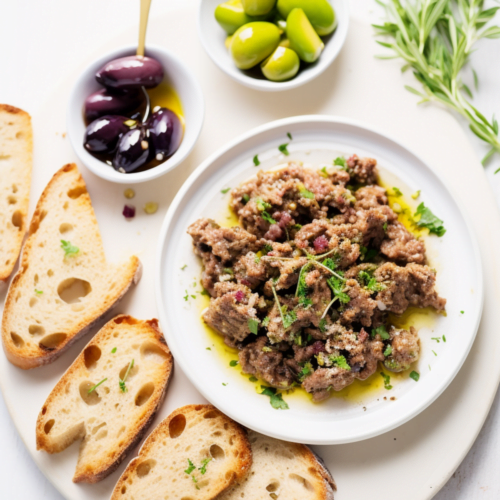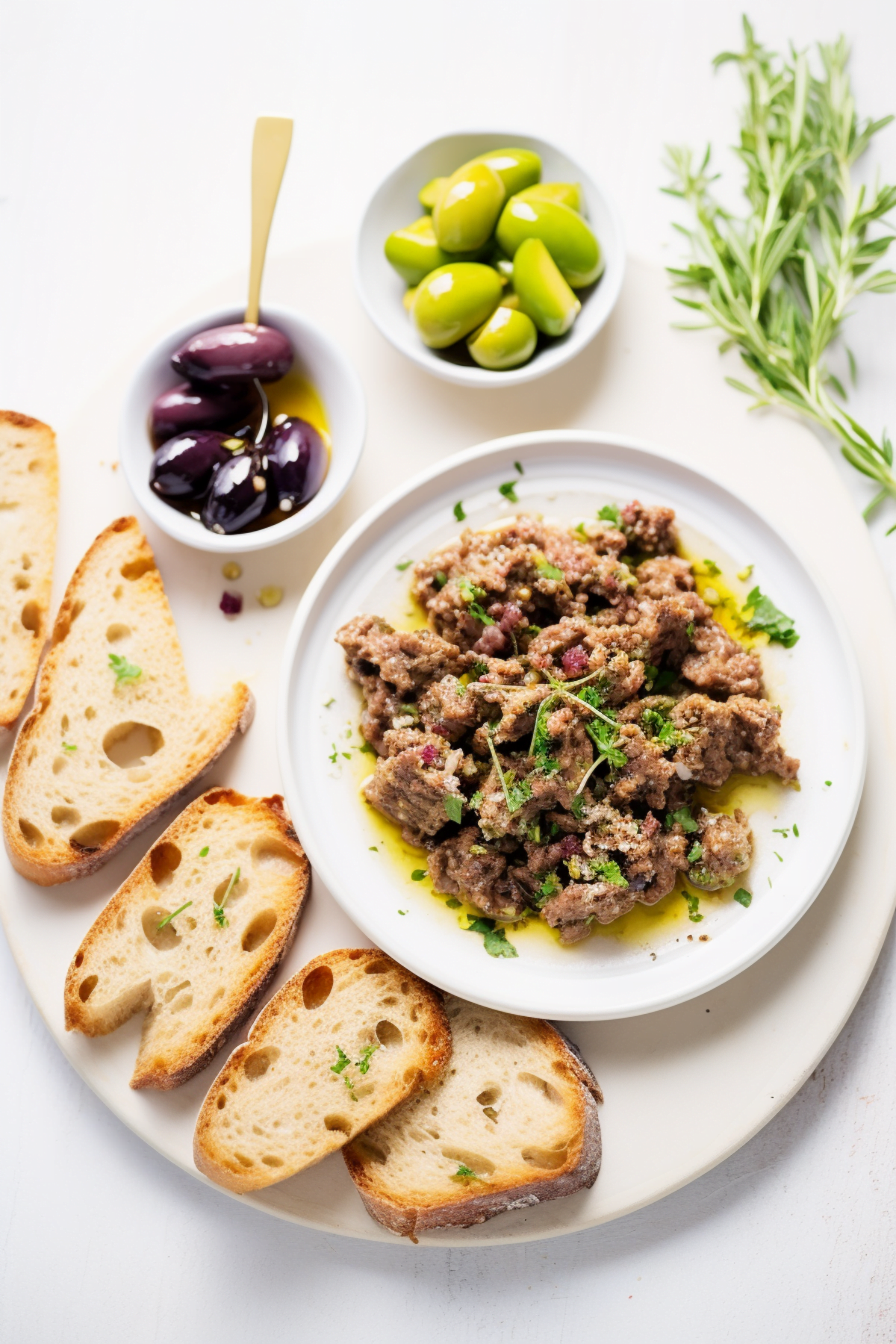Discover the Rich Flavors of Croatian Olive and Fig Tapenade with Crostini
Welcome to a culinary journey that will transport your taste buds to the stunning coastlines of Croatia. Here, you will uncover the secrets of making an authentic Croatian Olive and Fig Tapenade served with golden, homemade crostini. This appetizer is not just a dish, but a story of the region’s rich history, told through its vibrant flavors and fresh ingredients. Whether you’re hosting a dinner party or looking for a delightful snack, this tapenade is sure to impress.
Imagine the perfect blend of the savory tang of Kalamata olives with the natural sweetness of figs, combined to create a spread that is both rustic and refined. It’s a taste that evokes the spirit of Croatian hospitality and the Mediterranean’s love for sharing good food with great company. So, let’s embark on this flavorful adventure together and learn how to make this delectable appetizer that will become a staple in your culinary repertoire.

The Story Behind Croatian Olive and Fig Tapenade
The Croatian Olive and Fig Tapenade is a dish deeply rooted in the Mediterranean tradition, where olives and figs are staple crops basking in the Adriatic sun. This recipe draws inspiration from the Dalmatian coast, known for its pristine waters, ancient olive groves, and fig trees that have been part of the landscape for centuries. The tapenade is a celebration of these simple yet exquisite flavors that are quintessential to Croatian cuisine.
The use of olives in Croatian cooking dates back to the times of the ancient Greeks and Romans, who introduced olive trees to the region. Kalamata olives, specifically, are prized for their rich, fruity flavor and are a key ingredient in this tapenade. Figs, on the other hand, provide a natural sweetness and texture that balances the briny olives. This recipe is a testament to the Croatian way of life, where food is prepared with care and enjoyed at a leisurely pace, often accompanied by a glass of local wine.
Traditionally, tapenade is a Provençal dish, but the Croatian version has its unique twist by incorporating figs, a beloved local fruit. This appetizer is not only a staple in Croatian households but also a popular choice in konobas, the country’s quaint taverns where locals gather to savor home-cooked meals. The combination of olives, figs, capers, and aromatic herbs creates a spread that is both versatile and unforgettable, making it a perfect representation of Croatia’s culinary heritage.

Mastering the Method for Perfect Tapenade and Crostini
Creating the perfect tapenade is an art form that begins with selecting the finest ingredients. For the crostini, choose a baguette with a good crust and a soft interior to achieve that desirable crunch. When toasting, keep a watchful eye to ensure they reach a golden hue without burning. The key is to achieve a balance between crispness and the ability to hold the tapenade without breaking.
As for the tapenade, the process is straightforward but requires attention to detail. Start by pulsing the olives, figs, and other ingredients in the food processor until coarsely chopped. It’s crucial to retain some texture for an authentic experience. When adding the olive oil, do so gradually to emulsify the ingredients into a cohesive paste. The goal is to create a spread that’s rich and thick, yet spreadable.
Seasoning is the final touch that brings the tapenade to life. Freshly ground black pepper enhances the flavors without overpowering them. If you’re aiming for a more traditional texture, refrain from over-processing. The tapenade should have character, with discernible bits of olives and figs, much like the rugged Croatian landscape itself. Serve it with the crostini and watch as your guests marvel at the depth of flavors you’ve crafted.

Variation: Dalmatian Delight
For a Dalmatian twist, incorporate anchovies into the tapenade for a hint of umami. The salty fish is a common ingredient in the coastal regions and will add another layer of complexity to the dish.
Variation: Istrian Infusion
Inspired by the Istrian peninsula, known for its truffles, add a small amount of truffle oil or finely chopped truffles to the tapenade. This luxurious addition will elevate the spread, making it fit for the most sophisticated palates.
Variation: Slavonian Spice
Channel the flavors of inland Croatia by adding a touch of paprika, reflecting the Slavonian love for hearty and warm spices. This variation adds a subtle smokiness that complements the olives and figs beautifully.
Substitutions for Croatian Olive and Fig Tapenade
If Kalamata olives are not available, you can substitute them with other black olives, such as Niçoise or Gaeta. These varieties still provide the rich, fruity flavor essential to the tapenade’s character.
For those who cannot find fresh figs, dried figs are an excellent substitute. They concentrate the sweetness and provide a chewier texture, which can be a delightful contrast in the spread.
And for a non-alcoholic pairing, opt for a sparkling grape juice or a tart pomegranate juice to mimic the acidity and complexity of wine, ensuring all guests can enjoy the full experience.
Frequently Asked Questions
| Can I make the tapenade ahead of time? | Yes, preparing the tapenade in advance allows the flavors to meld. Store it in an airtight container in the refrigerator for up to a week. |
| Is this recipe suitable for vegetarians? | Absolutely, the Croatian Olive and Fig Tapenade is vegetarian-friendly and can be vegan if you ensure the bread is made without animal products. |
| How can I achieve a smoother tapenade? | For a smoother consistency, continue to process the mixture until it reaches your desired texture. |
| What can I serve with the tapenade besides crostini? | The tapenade pairs well with crackers, fresh vegetables, or as a spread in sandwiches. |
| Can I use fresh figs instead of dried? | Yes, fresh figs can be used, but they will alter the texture and moisture content of the tapenade, so adjust accordingly. |

Croatian Olive and Fig Tapenade with Crostini
Equipment
- Baking sheet
- Food processor
- Bread knife
- Pastry brush
Ingredients
- 1 cup Kalamata olives, pitted 150g / 5.3 oz
- 1/2 cup dried figs, stemmed and quartered 75g / 2.6 oz
- 2 tbsp capers, rinsed 30g / 1 oz
- 2 cloves garlic, minced 6g / 0.2 oz
- 1 tbsp fresh lemon juice 15ml
- 2 tsp fresh thyme leaves 2g / 0.07 oz
- 1/3 cup extra virgin olive oil 80ml, plus extra for crostini
- Freshly ground black pepper, to taste
- 1 baguette, sliced diagonally into 1/2 inch thick slices 200g / 7 oz
- Salt, to taste
Instructions
- Begin by preheating your oven to 350°F (175°C). This will be for toasting the crostini.
- Arrange the baguette slices on a baking sheet in a single layer. Brush each slice lightly with olive oil and sprinkle with a pinch of salt.
- Toast the baguette slices in the preheated oven for about 10 minutes, or until they are golden and crisp. Once done, set aside to cool.
- While the crostini are toasting, place the pitted olives, quartered figs, capers, minced garlic, lemon juice, and thyme leaves into the bowl of a food processor.
- Pulse the mixture several times until it is coarsely chopped but not pureed, ensuring to retain some texture.
- With the food processor running, slowly drizzle in the extra virgin olive oil and blend until the mixture becomes a cohesive paste. Season with freshly ground black pepper to taste.
- Transfer the tapenade to a serving bowl.
- Serve the Croatian Olive and Fig Tapenade with the prepared crostini. The tapenade can also be refrigerated in an airtight container for up to a week.
Notes

